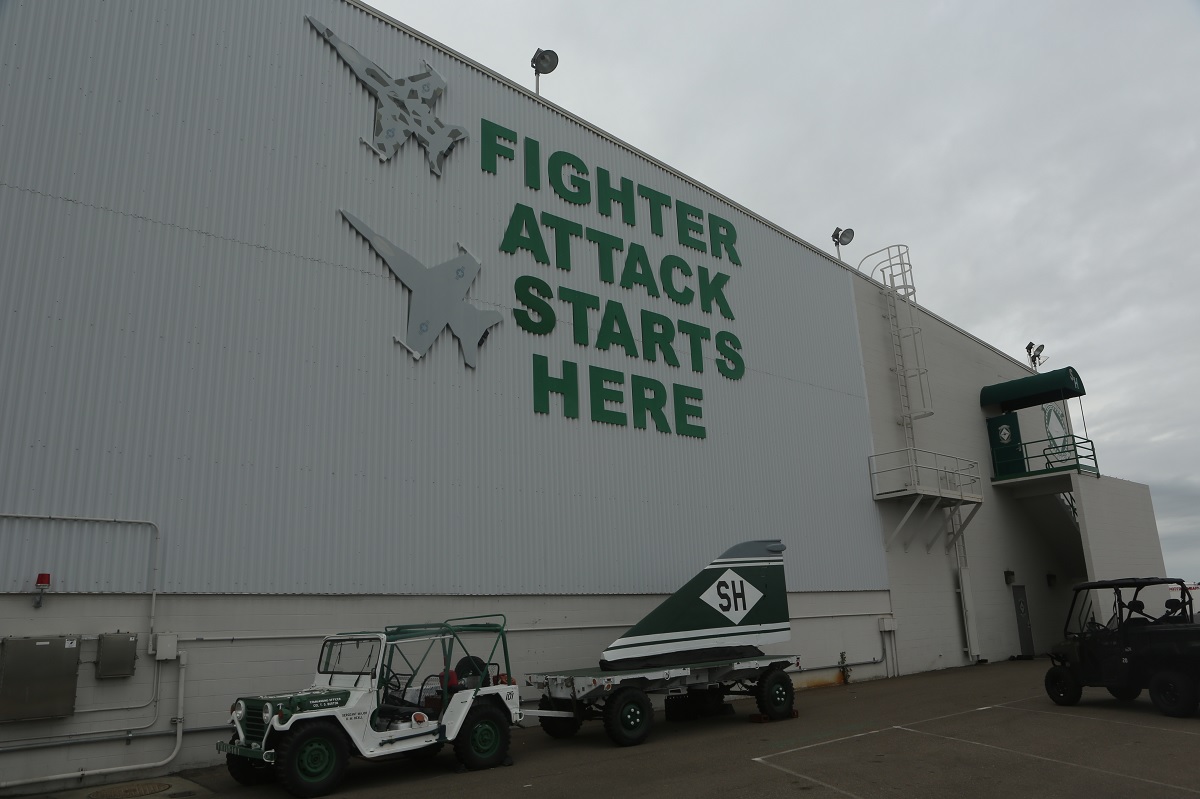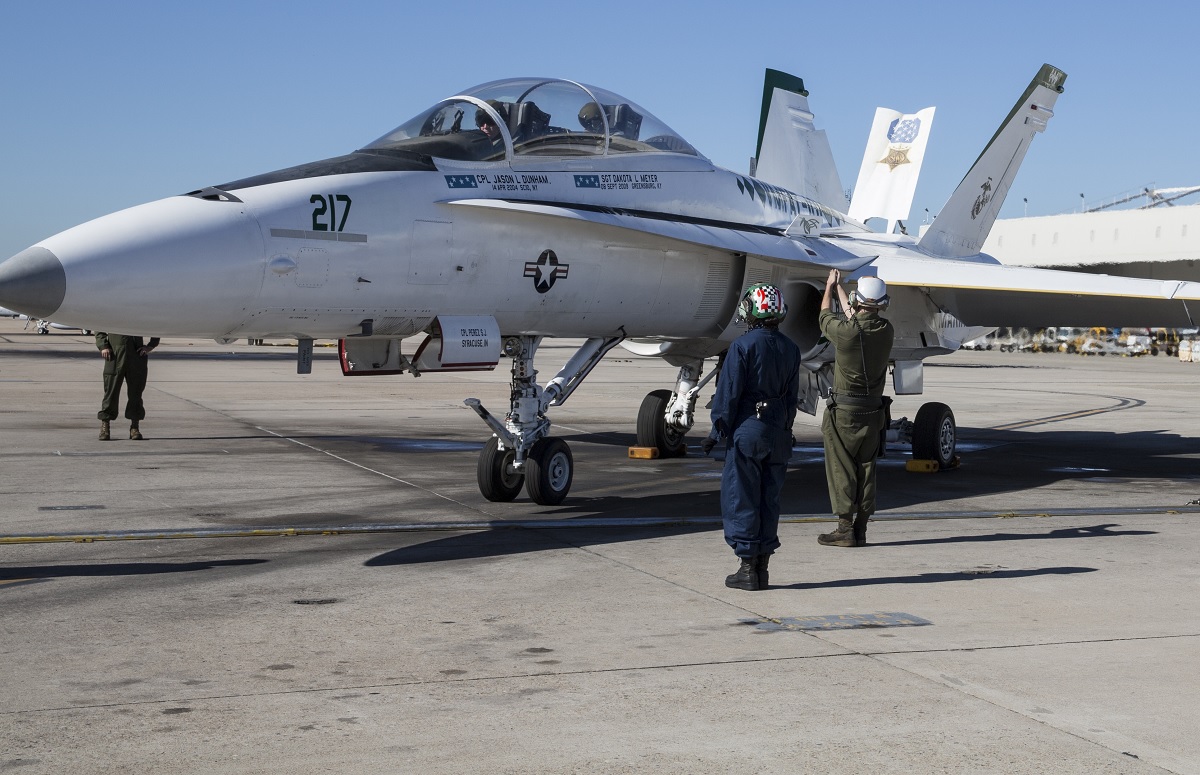A designated Marine Corps F/A-18 aviator must complete nearly four years of training
The largest F/A-18 Hornet squadron in the U.S. Marine Corps is Fighter Attack Training Squadron (VMFAT) 101 “Sharpshooters” (USMC). The unit is headquartered at Marine Corps Air Station (MCAS) Miramar in California and is a member of the 3rd Marine Aircraft Wing (3rd MAW).
Since the squadron has around 60 F/A-18 Hornets, as detailed by Lance Cpl. Liah Kitchen in the article Fighter Attack Starts Here: ‘Sharpshooters’ make Marine aviators, a large number of Marines and Sailors are needed to serve as pilot instructors, students, plane captains, and maintainers.
“The mission at VMFAT-101 is to train unqualified replacement pilots and weapons systems officers so that they are able to enter the fleet as fully qualified,” explained Capt. Jordan Meredith, a VMFAT-101 pilot instructor, and the squadron adjutant. “We take unpolished aviation officers and send them to the fleet as polished F-18 pilots and weapons systems officers.”

The one-year program turns novice fixed-wing pilots into fully qualified F/A-18 pilots and weapons systems officers (WSOs).
“During my training with 101, I’ve been experiencing what it really means to be a part of Marine Corps aviation,” pointed out 1st Lt. Ray Rickenbach, VMFAT-101 WSO student. “Our main mission is to support the Marines on the ground by conducting flight operations.”
A designated Marine Corps F/A-18 aviator must complete nearly four years of training, according to Meredith. Officers must complete The Basic School in Quantico, Virginia, then commission as second lieutenants in the Marine Corps. After that, aviation officers are dispatched to Naval Air Station (NAS) Pensacola for six weeks of Aviation Pre-Flight Indoctrination (API) training.

Then, for their initial flight training, officers travel to either NAS Whiting Field in Florida or NAS Corpus Christi in Texas. At the conclusion of primary flight school, officers choose the platform of aircraft they will fly in the fleet Marine force based on class rank and availability.
Officers who are chosen to operate with jets travel to NAS Meridian, Mississippi, to enroll in an Advanced Training program in order to “earn their wings.” They come to VMFAT-101 as part of a F/A-18 aviator’s final training to become fully qualified F/A-18 fighter pilots.
“I look forward to finally serving the Marine Corps as a part of the aviation combat element in a Marine air-ground task force,” said Rickenbach.
Marines and Sailors stationed at VMFAT-101 have a distinct experience advantage over Marines stationed with a deployed F/A-18 squadron since they are essential to maintaining the aircraft so that the students can participate in flight operations.

“Because we have all four models of the F-18, we are able to get our hands on different discrepancies, you don’t normally face with a typical gun squadron,” said Sgt. Elizabeth Coble, the noncommissioned officer in charge of the communication and navigation section of VMFAT-101. “Without the knowledge to fix the aircraft, the students aren’t able to fly and can’t accomplish the squadron’s mission.”
On September 29, 1987, at MCAS El Toro, VMFAT-101 was designated as the third F/A-18 Fleet Replacement Squadron (FRS). The Sharpshooters had trained 25 competent instructor pilots by the end of October 1988, owned 21 F/A-18s, and were prepared to start training new Hornet pilots. By May 1989, the VMFAT-101 had graduated 23 new F/A-18 pilots and logged more than 11,000 hours of trouble-free Hornet flight. The squadron began its sixth year without an incident or casualty in December 1989.
VMFAT-101 received its first two-seat F/A-18D Hornet on January 10, 1990, and started preparing the aircrew for the switch to the Hornet. Over 150 Hornet aircrew had graduated from the Sharpshooters by June 1990, and they had over 28,000 F/A-18 A, B, C, and D that came from lots VI through XII. Lt. Col. “Cajun” Tullos completed the squadron’s 50,000 hours of accident-free flight on August 27, 1990. The Sharpshooters often deployed to MCAS Yuma, Arizona, and MCAS Miramar, California, for detachments of fighter weapons training, as well as to every West Coast aircraft carrier for carrier qualifications.
The Sharpshooters are currently prepared to take on both present and future problems. Since it began 20 years ago, producing highly skilled aircrew trained to staff the fleet squadrons has been the principal objective.

Source: U.S. Marine Corps; Photo by Lance Cpl. Liah Kitchen, Cpl. Melissa Lee and Lance Cpl. Rebecca Eller / U.S. Marine Corps

